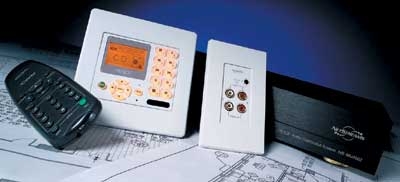Music Around the House Page 4
NetStreams is relatively new to housewide audio, but it has quickly emerged with some innovative products. The basic Musica system distributes four sources to six zones. 
The heart of Musica is the MU4602 Audio Distribution Center, or ADC (rear in photo above, back panel below, $1,600), which has only a single power LED on its front panel. All the action happens around back, where you'll find six RJ-45 sockets and six two-pin connections for each keypad, stereo RCA inputs for four sources, and four minijack IR outputs. Three more two-pin connectors are provided for a separate power controller and a door-bell/phone mute, along with a two-way RS-232 communications port. 
The ADC comes with a remote control (far left) that mirrors the buttons found on the keypad (center left), which includes a stereo amp for the local speakers. Local sources are easily added with AP300 audio ports (middle, $130 each) - they appear on the keypad's screen as Ext. Audio and are available to that zone. The AP300 includes a stereo RCA input and RCA line outputs so you can connect a powered subwoofer or outboard power amp. A minijack serves as either a local IR output or an input for the local source.
NetStreams offers three different but identical-looking keypads for the ADC, and I set up one of each kind. The basic keypad ($400) has a 25-watt-per-channel amplifier. For $500, you can step up to 50 watts per channel, and for $600, you get FM, too, with plentiful tuning options. Each of the ten buttons on the righthand side is dual-purpose - if you push and hold one, it sends a secondary command, providing 20 commands in all, including transport controls and adjustments for volume, balance, bass, and treble. Pressing and holding the off button powers the entire system down. The remaining buttons are a source toggle and a menu selector surrounded by cursors. The LCD screen indicates the source selection, activity in other zones, and the current volume setting, with a choice of amber or green backlighting. There are 40 choices available for source names.
Musica requires running Cat-5 cable and speaker wire from the ADC to each keypad, then speaker wire from the keypad to each speaker and Cat-5 cable from the keypad to the local-audio port, if any. Each keypad has two RJ-45 jacks for the Cat-5 input and output. There are also screw-down connections for power input and speaker output, but I found that the ones for the speakers were reversed - following the labels connected my speakers out of phase.
is done directly into a keypad, and the manual walks you through the procedure. Once you complete the programming, powering the keypad down "teaches" all of the commands to the other pads. Anyone who's ever worked with a learning remote control should breeze through the process. I had my three sources (CD, DVD, cable box) set up in less than 10 minutes.
Home computer networks are becoming increasingly common, and NetStreams' MUR2E Network Interface ($450) lets you take advantage of one. Once you connect the MUR2E to your home network and the Musica ADC's RS-232 port, and install the supplied Windows software on a networked PC, you'll be able to control all of Musica's functions from any computer on the network. Each zone is independently accessible, and your entire home can be synced to the same volume setting and source selection for, say, a housewide party. Computer navigation and control are simple and worked without a hitch.
Given the power ratings, I was expecting decent volume from the Musica system. However, the 25-watt-per-channel keypad just didn't have enough oomph to fill a large room, and the dynamic range seemed limited. I usually found myself pushing the volume setting up to 30 or higher (out of 35, tops). The sound using the 50-watt pad was noticeably fuller, but it still couldn't match the volume or richness I heard from the Elan or Z?N systems, which have lower rated power (40 and 30 watts per channel, respectively).
Music sounded trebly, without much bass, making it seem almost harsh at higher volumes. FM reception when using the high-end keypad was on par with my A/V receiver. Operating the system using the keypad was a treat, sort of like having a universal remote in each room. PDF: Fast Facts




























































